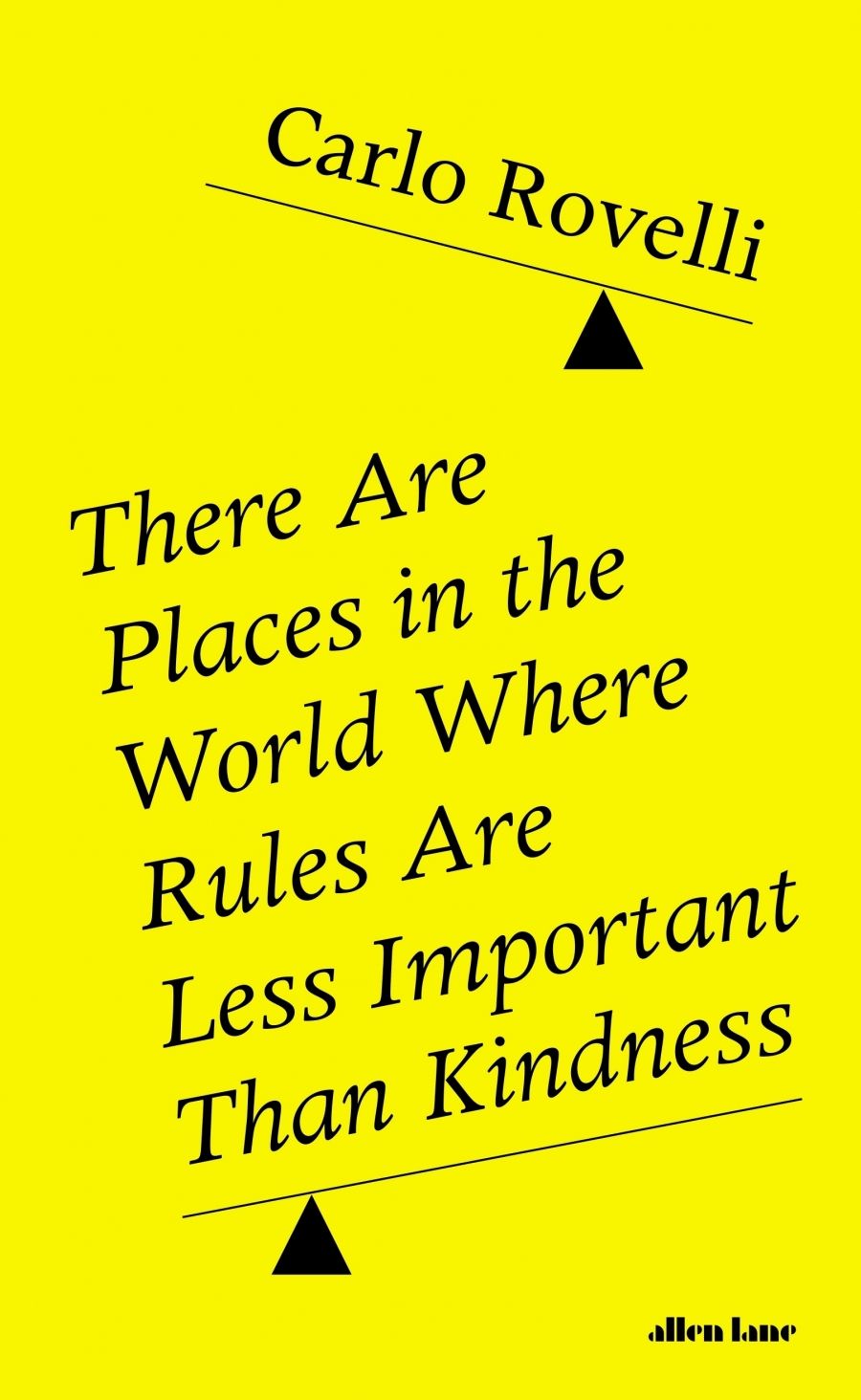
- Free Article: No
- Contents Category: Science and Technology
- Review Article: Yes
- Article Title: Rovelli’s tasting plate
- Article Subtitle: Exploring the double helix of science and culture
- Online Only: No
- Custom Highlight Text:
In a recent interview, Italian physicist Carlo Rovelli confessed that the book he would most like to be remembered for is The Order of Time (2018), a work in which time, as it is commonly understood, ‘melts [like a snowflake] between your fingers and vanishes’. The Order of Time, Rovelli admits, only pretends to be about physics. Ultimately, it’s a book about the meaning of life and the complexity of being human.
- Grid Image (300px * 250px):

- Book 1 Title: There Are Places in the World Where Rules Are Less Important Than Kindness
- Book 1 Biblio: Allen Lane, $35 hb, 230 pp
- Book 1 Readings Link: booktopia.kh4ffx.net/NKBPX2
A collection of newspaper columns written over a period of ten years, There Are Places in the World offers Rovelli the opportunity to consider more overtly the philosophical questions prompted by scientific research. Sketching thought-provoking connections between science, knowledge, faith, poetry, and politics, and meandering from Aristotle to Mein Kampf, Marie Curie to Vladimir Nabokov’s butterfly research, the book is a tasting plate of Rovelli’s insights and scholarship. If there is a unifying theme, it is the double helix of science and culture; that the advancement of one depends absolutely on the advancement of the other.
The greatest literature, Rovelli contends in a piece drawing on the work of Lucretius, Milton, and Robert Musil, ‘has sought to come to terms directly with the scientific vision of the world’. Both poetry and science are ‘manifestations of the spirit that creates new ways of thinking the world’, a point reinforced in an essay on Paradiso, which demonstrates Dante’s intuiting of a ‘three-sphere’, the shape which, several centuries later, Einstein would hypothesise as the shape of the universe.
Creativity, whether in science or the arts, depends on a ‘deep immersion in contemporary knowledge’; on the investigation of those fracture lines, the contradictions and uncertainties, that exist in what we know. While the notion of paradigm shifts in science has gained prominence through the writing, for example, of Thomas Kuhn, Rovelli champions the cumulative and gradual reconstruction of scientific knowledge: ‘In the great ship of modern physics we can still recognise its ancient structures.’
The endeavours of scientists, their breakthroughs and their failures, figure prominently. Rovelli convincingly argues the importance of the flourishing Italian Renaissance to the imaginative leap which enabled Copernicus to articulate his new model of the universe, one that displaced Earth, and humanity, from their place at the centre of creation. Stephen Hawking is commemorated for both his work on Hawking radiation (the heat which emanates from black holes) and for his boundless curiosity; Newton for his interest in alchemy, a preoccupation which, according to Rovelli, demonstrates the exemplary nature of Newton’s science and his appetite for probing the boundaries of knowledge.
Einstein and his work are recurring preoccupations, and what Rovelli most admires about Einstein are his mistakes. He refers to the 1917 paper in which Einstein set out his cosmological theories as ‘a strange mixture of major new and revolutionary ideas and a mass of serious errors’. It was, Rovelli asserts, Einstein’s willingness to be wrong, to alter and discard inadequate theories, that underpinned his deep understanding of the workings of the universe.
The most sustained section of the book consists of a series of pieces on black holes. Rovelli traces the evolution of our understanding of these extreme manifestations of space-time, from Einstein’s first equations describing general relativity to current theories regarding white holes, those regions of space which are the ‘time reversal of a black hole … into which nothing can enter, but from which things emerge. A hole that explodes.’
Mathematics are considered: the combination of a few simple objects – such as the four bases that make up DNA – which gives rise to ‘an unexpected vastness’ of possibilities; and Archimedes’ estimation of the number of grains of sand required to fill the universe (he came up with an answer of 1063). Religion is also a frequent concern. Buddhist notions of self – that the self subsists only in the relationships that constitute it – are admired for giving a coherent shape to the enigmas of quantum mechanics and for opening up new ways of thinking about existence. And a simple gesture of kindness in an African mosque precedes an epiphany which suggests that humanity is inexorably drawn towards ‘the essential, the absolute’.
Rovelli is a charming and accessible writer, disposed to speculate on topics as varied as global warming, traditional medicines, multiple universes, LSD, free will, and, inevitably, Covid-19. He may seem to be venturing far outside his speciality (which is the physics of quantum loop gravity, one of the primary theories seeking to reconcile Einsteinian relativity with quantum mechanics), but the questions he grapples with here, questions of meaning and existence, emanate directly from his reflections on quantum physics. You may not always agree with the conclusions he draws, but he is a thinker whose views are invariably worth heeding.
Reading Carlo Rovelli, the writer I am most reminded of is Carl Sagan. Both share a profound understanding of the uphill struggle of scientific progress, the confounding nature of our existence, and the inherent poetry of the universe. And while there is nothing here that quite matches Sagan’s evocation of the ‘pale blue dot’, there is a reverence for the unknown that Sagan would have appreciated. ‘Between certainty and complete uncertainty there is a precious intermediate space,’ Rovelli writes, and it is in this space that ‘our lives and our thoughts’, as well as our science and our culture, ‘unfold’.


Comments powered by CComment